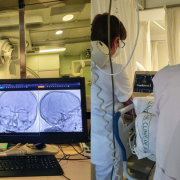Prominent Members Under 45: Interview with Diana Aguiar de Sousa
For 2018, via the ESO newsletter, we are focusing the spotlight on prominent ESO members under 45. In January we introduced you to Georgios K. Tsivgoulis. For February, we learned more about Else Charlotte Sandset. In March we presented Urs Fischer. In April you met Charlotte Cordonnier.
Hopefully you were able to meet some of these prominent young members in person during the ESOC in May. From the ESOC, the Young Stroke Physicians and Researchers Committee published daily interviews with Ayse Tanritanir, Stefania Nannoni, and Maren Ranhoff Hov.
In the June edition of this series Marialuisa Zedde answered questions for July, we introduced Jesse Dawson.
This month we sat down with Diana Aguiar de Sousa. Diana was awarded with a European Stroke Organization (ESO) Young Investigator Award in 2016. She is an active member of the ESO Young Stroke Physicians and Researchers Committee and contributes to the ESO blog, The Voice of Stroke.
What is the added value of a young researcher to the activity of a Stroke Team?
Mentorship is a two-way street. Young researchers know they have to deliver value for the team while receiving guidance and knowledge from senior elements. Most often they are happy to take more tedious tasks and are highly enthusiastic about new projects, motivating the whole group. Besides, being somewhat naïve allows one to take unusual approaches to addressing questions and appreciate interdisciplinary topics, breaking down the “walls” or bridging with novel domains. We should also not forget that, if junior investigators do not see a future for themselves in research, the whole scientific enterprise would be weakened after some years. Therefore, engaging researchers of all generations in teams should probably be the best way to maintain this good momentum in stroke science. Hopefully, support of young investigators will build a new generation of researchers that can bring imaginative ideas to the field. But even if, naturally, some young investigators do not engage in independent research in the future, we know this training will help them to interpret the literature, apply evidence to patient care and become a more reflective and competent doctors. So I do believe there is always added value in involving young people in research teams.
What has ESO added and what do you aspect ESO to add in the future to grow a new generation of stroke clinicians/researchers?
Nowadays young clinicians and researchers probably enjoy much more training opportunities then the past generations. However, they also face great pressure, which comes both from the modern systems of health care and the current global and highly technical research landscape. ESO has clearly acknowledged this and made a significant progress in its educational agenda in recent years, having now an impressive annual programme of events. Throughout the year ESO organizes several courses for trainees, as the popular summer and winter schools. Besides, ESO meetings (ESOC, ESO Stroke Science Workshop and the ESO-Karolinska Stroke Update Conference) always have a good portfolio of educational activities and are an excellent opportunity for young physicians to glimpse into future developments and meet leaders in stroke research. The growing development of the young stroke physicians and researchers (YSPR) committee activities is another key tool to give voice to this group in the society and serve their specific needs and goals. The committee, led by Else Sandset, is currently supporting several initiatives that focus both on educational and career development issues. The collaboration with the ESO blog and, more recently, with the European Stroke Journal, are also part of this strategy to increase the visibility and recognition of European researchers, including the new generation, while sharing knowledge. On top of that, these activities also provide a platform for networking amongst international young investigators. So I think ESO has, and will continue to have, a pivotal role in the education and collaboration of young stroke physicians in Europe, which promotes quality improvement in stroke care and research and ensures the longevity of the organization.
What are your main fields of interest in stroke research?
Currently I am pursuing a PhD in the field of cerebral venous thrombosis. I also had recently the great privilege to collaborate in an international survey of national scientific societies and stroke experts in Europe, which was the result of a collaboration of ESO, ESMINT, EAN and SAFE. Importantly, the findings of this pan-European survey showed that many patients still have no access to appropriate acute stroke treatment. Thus we hope this data can assist decision makers implementing tailored stroke care programmes and we are planning to update these indicators in the future.
How do you manage clinical and research activity in your daily routine?
Finding the right time balance between clinical and academic work is a challenge for everyone. I am very fortunate to work with excellent teams in the hospital, in the university and in my research group, in which everybody does their best and support each other. The long-standing support of my husband and family are, of course, also very important.
Short biography
Diana Aguiar de Sousa is Neurologist at Hospital de Santa Maria, in Lisbon, and assistant professor of Neuroanatomy at University of Lisbon. She is clinical investigator at Instituto de Medicina Molecular and PhD student at University of Lisbon, under the guidance of Prof. JM Ferro and Prof. P Canhão. She completed the Clinical Scholars Research Training Certificate Program from Harvard Medical School and a European Academy of Neurology Research Fellowship in acute stroke at Inselspital Bern, Switzerland.




